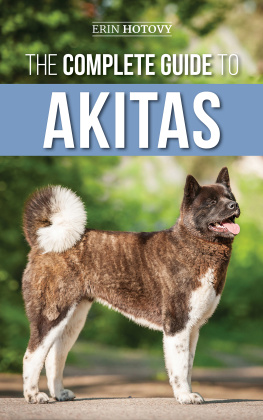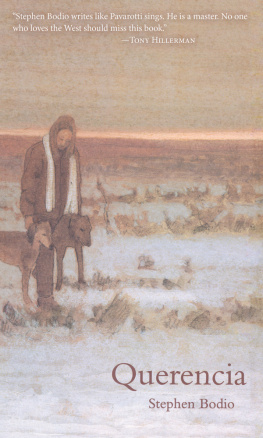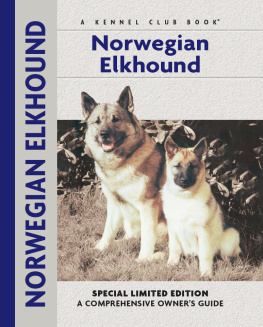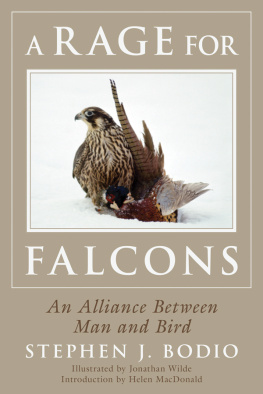Copyright 2016 by Stephen J. Bodio
All rights reserved. No part of this book may be reproduced in any manner without the express written consent of the publisher, except in the case of brief excerpts in critical reviews or articles. All inquiries should be addressed to Skyhorse Publishing, 307 West 36th Street, 11th Floor, New York, NY 10018.
Skyhorse Publishing books may be purchased in bulk at special discounts for sales promotion, corporate gifts, fund-raising, or educational purposes. Special editions can also be created to specifications. For details, contact the Special Sales Department, Skyhorse Publishing, 307 West 36th Street, 11th Floor, New York, NY 10018 or .
Skyhorse and Skyhorse Publishing are registered trademarks of Skyhorse Publishing, Inc., a Delaware corporation.
Visit our website at www.skyhorsepublishing.com.
10 9 8 7 6 5 4 3 2 1
Library of Congress Cataloging-in-Publication Data is available on file.
Cover design by Tom Lau
Cover photo credit: Stephen Bodio
Cover Illustration: River Crossing, Chinese Hunter by Vadim Gorbatov
Print ISBN: 978-1-5107-0571-5
Ebook ISBN: 978-1-5107-0572-2
Printed in the United States of America
To Sari, who started the whole thing;
to Beth, who gave me the engine;
and to Libby, who drove it home.

Contents

To Stephen Bodio By Tim Murphy
I dreamed I was striding beside your horse,
dogs coursing in the mist,
the falcon on your fist
husbanding her inconceivable force.
Shaheen, hoping that we were hunting quail,
spiraled aloft to hover
as we quartered her cover.
Over the brush we saw a single sail,
then broke the covey. At an explosive flush
the blinding stoop and kill.
On a High Desert hill
she nibbled neck meat in the windless hush.
Yours is the hunters highest form of art.
Beside my prairie stream
I read your books and dream,
sharing the wild passion in your heart.

The Hounds of Heaven

Stuff is eaten by dogs, broken by family and friends, sanded down by the wind, frozen by the mountains, lost by the prairie, burnt off by the sun, washed away by the rain. So you are left with dogs, family, friends, sun, rain, wind, prairie and mountains. What more do you want?
Federico Calboli

The hounds are running in the grass, over the plains, running out of the past. They are not like the hounds of the old Stone Age; those have prick ears and gray ruffs like wolves. These have long legs, liquid eyes, silken coats, soft pendant ears, barrel-vault ribs, hard muscles, wasp waists. These are the second mutationthe dogs of the Neolithic steppe, the dogs that come from the north edge of the Tian Shan, the Heavenly Mountains. They are the hounds of heaven.
They run like a wind in the grass with teeth, to quote Andrew Jackson Frishman. They hunt with falcons and horses and human partners and fly like falcons on the ground. They seem to float above the earth until they thunder by. The Kazakh zoologist Vladimir Shakula says they have a drop of the blood of the Eastern Dragon.
They run on six-thousand-year old rock paintings and seventh-century Chinese tombs. They run in Asia from Xinjiang and down the old Silk Road past Almaty, Bishkek, down through the high passes over Tajikistan and Afghanistan that lead to India, through Persia and Turkey all the way south and west to Arabia Felix. They are named tazi, khalag, bakhmul, aboriginal Afghan, and finally saluki as they approach their western and southern borders. They run on the steppes north to Siberia and on ranches in New Mexico.
They sleep in the yurts of the Kazakhs and the Kyrgiz, where perhaps they always have, and in the black tents of the Bedouin, for although they are dogs, theyat least until recentlywere also hurr, or noble, like the saker falcon and the horses that came with them down the Silk Road. They are sweet yet aloof, endlessly loyal, quick to take offense, loving, and fiercely predatory.
They are the hounds of heaven, and they are running.

PROLOGUE
From Brooklyn to Kazakhstan

W here do obsessions begin?
In 1954, I was a just a toddler living on the second floor of a three-decker house in Dorchester, a blue-collar part of Boston. But even in that unlikely environment, where the only nonhuman living things were sparrows, pigeons, the ragmans cart horse, and the mouse that drowned in my bedside water glass, I was improbably fascinated by animals and animal tales. My father was an art student turned engineer by the GI Bill. He was still a dedicated hunter and fisherman then, and the fish and game he brought homebrilliant native brook trout with crimson and white fins on a bed of aquatic weed in his old wicker creel, a thick black duck with silken plumage and a startling blue speculummust have stimulated the biophilic genes that I doubtless inherited from him.
But my always-urban mother inadvertently planted some seeds, too. She started to read to me from Kiplings The Jungle Books when I was three, and by the time I was four I could not only recite passages aloud, but also, with her help and supplementary lessons from the foldout nature pages in Life magazineI remember creatures of the eastern forest by the wondrous Walter LinsenmaierI could suddenly read, and I have never looked back.
It is almost frightening to think how contingent circumstance and chance might affect a persons interests. My father was a sportsman, birder, and amateur naturalist; his interests are easily traced. But my mother was a commercial artist who, at the time, was drawing models for a fashionable Newbury Street furrier. She had been born in the city; her only interest in animals, and that was not a serious one, was as subjects. But she was a reader, a romantic, and maybe a little bored through the long day, so she taught me to read to have someone to talk to. Out of that boredom and loneliness came Kipling, The Jungle Book , Asia, animal stories, and even the artist Linsenmaier. I collect and quote Kipling, write about humans and animals and all their relations and memes with humans, and travel, mostly to Asia. I have Linsenmaiers book on insects, the most beautifulif not the bestof such books I have ever seen.
But she showed me an even more particular influence. In some lost magazine that I never forgot, a dark man in a spotted coat of blue-gray snow leopard furs and a shaggy striped hat sat on a horse; on his arm was an immense black eagle with an eyeless cap on its head. I told the story of my lifelong pursuit of that image in the book Eagle Dreams . It led me for the first time to the Asia of my dreams.
And, therefore, even though she never had nor wanted a dog, she led me to my dogs.
* * *
Fast forward twenty-some years and begin another trail. In the 1970s, a young editor and entrepreneur named Ed Gray launched Americas first consciously literary and artistic hunting and fishing magazine, Grays Sporting Journal . I was already writing various nature pieces and book reviews for Bostons alternative weekly papers, and I jumped at the chance to get paid some real money for writing about things I loved.

















